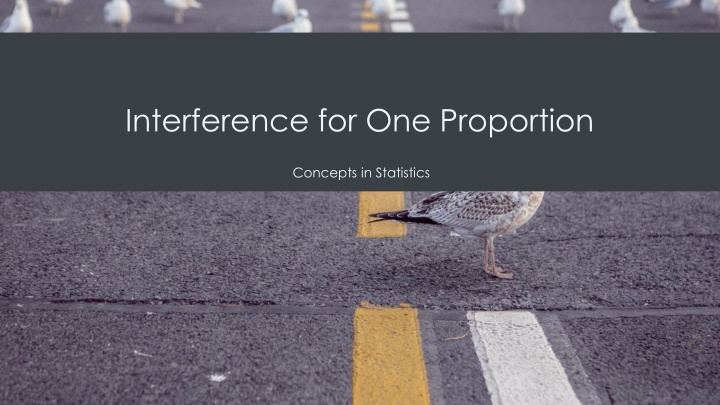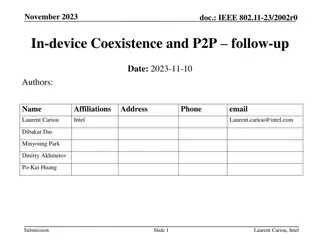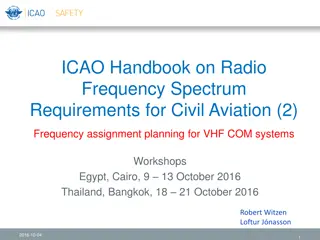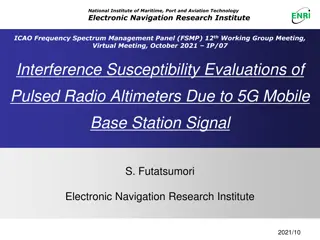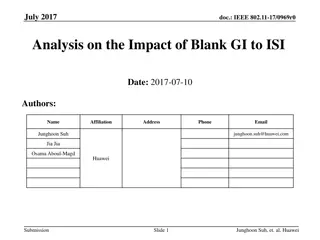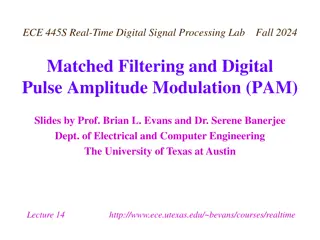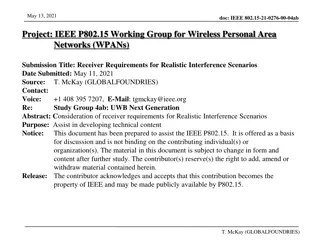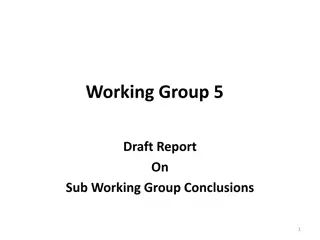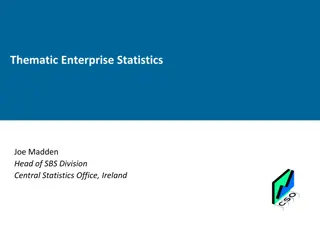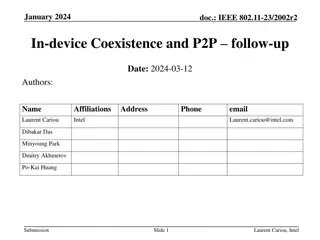Interference for One Proportion Concepts in Statistics
The concepts of interference for one proportion in statistics, covering research questions, estimating population proportion, confidence interval formulas, and more. Understand how statistical inferences are made.
Download Presentation

Please find below an Image/Link to download the presentation.
The content on the website is provided AS IS for your information and personal use only. It may not be sold, licensed, or shared on other websites without obtaining consent from the author.If you encounter any issues during the download, it is possible that the publisher has removed the file from their server.
You are allowed to download the files provided on this website for personal or commercial use, subject to the condition that they are used lawfully. All files are the property of their respective owners.
The content on the website is provided AS IS for your information and personal use only. It may not be sold, licensed, or shared on other websites without obtaining consent from the author.
E N D
Presentation Transcript
Interference for One Proportion Concepts in Statistics
Research Questions Type of Question Examples Variable Type Unit Make an estimate about the population What proportion of all U.S. adults support the death penalty? Categorical variable Inference for One Proportion Make an estimate about the population What is the average number of hours that community college students work each week? Quantitative variable Inference for Means Test a claim about the population Do the majority of community college students qualify for federal student loans? Categorical variable Inference for One Proportion Test a claim about the population Has the average birth weight in a town decreased from 3,500 grams? Quantitative variable Inference for Means Compare two populations Are teenage girls more likely to suffer from depression than teenage boys? Categorical variable Inference for Two Proportions Compare two populations In community colleges do female students have a higher average GPA than male students? Quantitative variable Inference for Means
Estimating a Population Proportion When we select a random sample from the population of interest, we expect the sample proportion to be a good estimate of the population proportion. We expect some error. For a given sample proportion, we will not know the amount of error, so we use the standard error as an estimate for the average amount of error we expect in sample proportions. If a normal model is a good fit for the sampling distribution, then about 95% of sample proportions estimate the population proportion within 2 standard errors. We say that we are 95% confident that the following interval contains the population proportion.
Population Proportion The standard error of the sampling distribution of sample proportions is given by ? 1 ? ? this formula: In this module we are estimating the population proportion p. So we estimate the standard error by replacing p with the sample proportion, which affects the margin of error in the confidence interval. We have the following adjustment to the confidence interval formula: ?(1 ?) ? ? marginoferror = ? 2
Confidence Interval Formula Since we are no longer restricting our confidence level to 95%, we can generalize the formula for a confidence interval: ?(1 ?) ? ? ?? We use a little subscript ? on the ?-score, ?? , to emphasize that the ?-score is connected to the confidence level. When giving the value of ??, we always use the positive ?-score.
Confidence Interval Technology often uses 3 decimal places for ?? For our most common confidence levels, the values of ?? are: 90% confidence interval: ?? 1.645 95% confidence interval: ?? 1.960 (2 is a rough approximation; 1.960 is more accurate) 99% confidence interval: ?? 2.576 So when you calculate the confidence interval, rounding will slightly affect the values in your interval.
Hypothesis Testing In inference, we use a sample to draw a conclusion about a population. Two types of inference are the focus of our work in this course: Estimate a population parameter with a confidence interval. Test a claim about a population parameter with a hypothesis test. We can also use samples from two populations to compare those populations. In this situation, the two types of inference focus on differences in the parameters. Estimate a difference in population parameters with a confidence interval. Test a claim about a difference in population parameters with a hypothesis test.
Forming Hypotheses We already know that in inference we use a sample to draw a conclusion about a population. If the research question contains a claim about the population, we translate the claim into two related hypotheses. The null hypothesis (?0) is a hypothesis about the value of the parameter. The null hypothesis gives the value of the parameter that we will use to create the sampling distribution. In this way, the null hypothesis states what we assume to be true about the population. The alternative hypothesis (??) usually reflects the claim in the research question about the value of the parameter. The alternative hypothesis says the parameter is greater than or less than or not equal to the value we assume to true in the null hypothesis.
Hypothesis Testing (cont.) General observations about null and alternative hypotheses: The hypotheses are competing claims about the parameter or the comparison of parameters. Both hypotheses are statements about the same population parameter or same two population parameters. The null hypothesis contains an equal sign. The alternative hypothesis is always an inequality statement. It contains a less than or a greater than or a not equal to symbol. In a statistical investigation, we determine the research question, and thus the hypotheses, before we collect data.
Hypothesis Testing Process
Statistical Significance The P-value is the probability of obtaining a test statistic at least as extreme as the one that was actually observed, assuming the null hypothesis is true. A small P-value indicates that it s unlikely the actual sample data came from the population described by the null hypothesis. We often compare the P-value to 0.05. We reject the null hypothesis in favor of the alternative if the P-value is less than (or equal to) 0.05. When the P-value is less than (or equal to) 0.05, we also say that the difference between the actual sample statistic and the assumed parameter value is statistically significant.
Statistical Significance (cont. 1) The number 0.05 is called the significance level, because a P-value less than or equal to 0.05 is statistically significant (unlikely to have occurred by chance). The symbol we use for the significance level is ?. If the P-value ?, we reject the null hypothesis in favor of the alternative hypothesis If the P-value > ?, we fail to reject the null hypothesis
Statistical Significance (cont. 2) Recall the conditions that make a normal model a good fit for the sampling distribution. When a normal model is a good fit, we use it to find probabilities. In this example, we can see that a normal model is a good fit for the sampling distribution, so we can find the P-value by calculating the ?-score and using a simulation.
Hypothesis Testing: Errors What Can Go Wrong: Two Types of Errors Statistical investigations involve making decisions in the face of uncertainty. In hypothesis testing, two types of wrong decisions can occur. If the null hypothesis is true, but we reject it, the error is a type I error If the null hypothesis is false, but we fail to reject it, the error is a type II error The following table summarizes type I and II errors:
What Is the Probability We Will Make a Type I Error If the significance level is 5% (? = 0.05), then 5% of the time we will reject the null hypothesis (when it is true!). We will not know if the null is true. But if it is, the natural variability that we expect in random samples will produce rare results 5% of the time. If the significance level is 1%, then 1% of the time sample results will be rare enough for us to reject the null hypothesis. In general, the probability of a type I error is ?
What Is the Probability We Will Make a Type II Error The probability of a type I error, if the null hypothesis is true, is equal to the significance level. The probability of a type II error is much more complicated to calculate. We can reduce the risk of a type I error by using a lower significance level. The best way to reduce the risk of a type II error is by increasing the sample size.
Hypothesis Summary The null hypothesis is always a statement of equality. The alternative hypothesis is always a statement of inequality, using <, >, or . So hypotheses take the form: H0: ? = ?0 Ha: ? < ?0 or ? > ?0 or ? ?0 We use ?0to represent the proportion from the null hypothesis.
Hypothesis Test for a Population Proportion The P-value for a hypothesis test for a population proportion comes from a normal model for the sampling distribution of sample proportions. The normal distribution is an appropriate model for this sampling distribution if the expected number of success and failures are both at least 10. Using the symbols for the population proportion and sample size, a normal curve is a reasonable model if the following conditions are met: ?? 10 and ?(1 ?) 10
Important Note A hypothesis test can be one- tailed or two-tailed. The previous example was a one- tailed hypothesis test. The P-value was the area of the right tail. If the inequality in the alternative hypothesis is < or >, the test is one- tailed. If the inequality is , the test is two-tailed.
Quick Review What does a confidence interval estimate? What is a null hypothesis? What procedure do you use when our goal is to estimate a population proportion? What is a type I error in hypothesis testing? What is the formula used to calculate the confidence interval for a population proportion? What is the first step when hypothesis testing for a population proportion? What inference procedure do you use when our goal is to test a claim about a population proportion?
